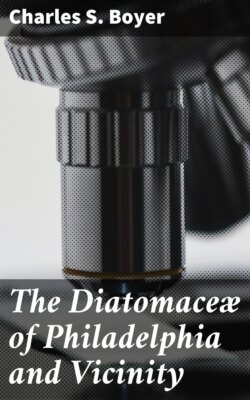Читать книгу The Diatomaceæ of Philadelphia and Vicinity - Charles S. Boyer - Страница 22
На сайте Литреса книга снята с продажи.
Stephanopyxis Ehr. (1844) em. Grun. (1884)
Оглавление(stephanos, a crown, and pyxis, a kind of vase or box)
Frustules ellipsoidal, concatenate; valves tumid, of unequal convexity, coarsely areolate, the cells in rows parallel to the longitudinal axis, not radiate, with stray spines or teeth placed concentrically more or less near the margin.
According to Karsten the chromatophores are round or angular discs which lie near the connective zone.
STEPHANOPYXIS TURRIS (GREV.) RALFS
Valve cylindrical, with a crown of stout spines less than the diameter of the valve near the margin. Cells hexagonal, about 2 in 10 µ, sometimes punctate. The valve having the greater convexity has the larger spines, though usually less of them.
Creswellia turris Grev. (Gregory, Diat. of the Clyde, T. R. S. E., vol. 21, part 4, p. 66.)
Stephanopyxis appendiculata Ehr.?
Creswellia is incorrectly based, as stated by Ralfs, on the concatenation of the valves which was not noticed by Ehrenberg in the fossil forms. It had been suggested by Kuetzing in Systema Algarum (p. 126).
Blue clay. Port Penn and Smith's Island.
Pl. 2, Figs. 1 and 2.
STEPHANOPYXIS CORONA (EHR.) GRUN.
Valve larger than in turris, sub-globose, coarsely areolate cells, 4-5 in 10 µ. One valve furnished with a crown of teeth shaped like the letter T and united at the top into a ring above the margin of the valve; the other valve with long spines more or less concentrically arranged.
Blue clay. Not common. Fossil in the Nottingham deposit.
Pl. 2, Fig. 3.
Note.—The diatomaceous deposit, so often called "Bermuda" or "Bermuda tripoli," especially by foreign writers, is in reality the Miocene stratum extending for miles along the Patuxent River near the village of Nottingham, Md. The author is perfectly familiar with the location, having made large collections there. The mistake in the name is due to the fact that Prof. Bailey received material from Mr. Tuomey marked "Bermuda Hundred," which is located near Petersburg, Va. Attempts have been made to find material there and while there is an earth containing Miocene diatoms at Petersburg, it does not exactly correspond to the material sent to Ehrenberg by Bailey, who was in doubt as to the locality. The Bermuda Islands are of coral formation and have no deposits of diatomaceous earth.
